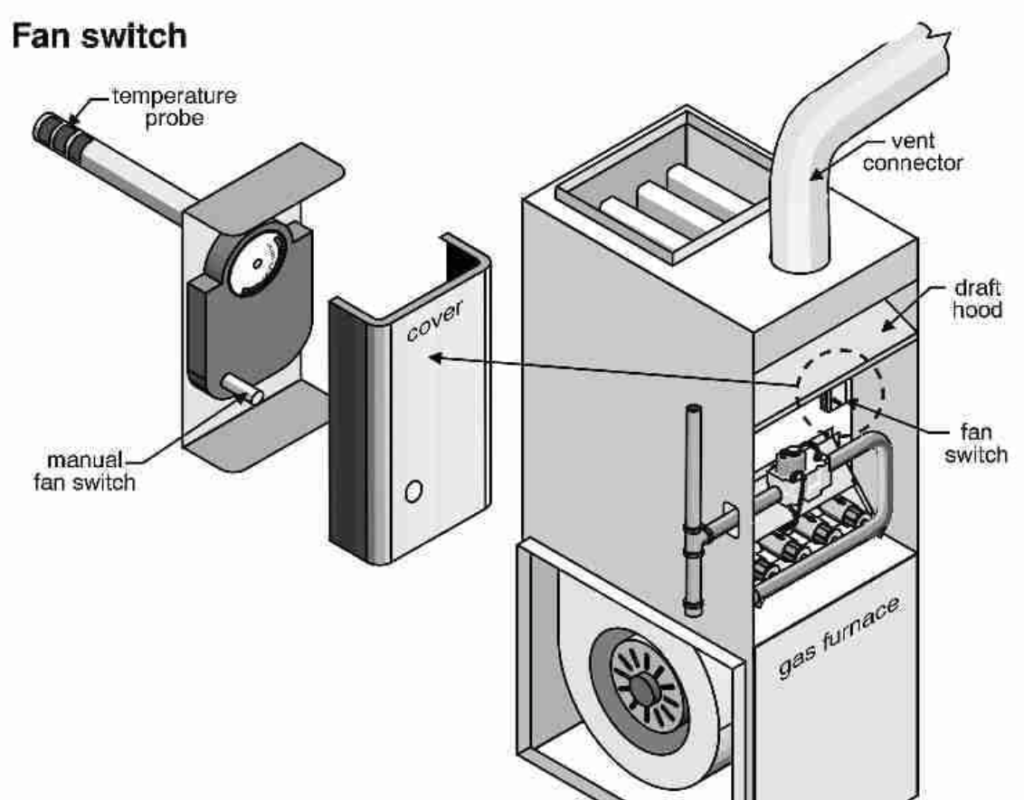What is a Furnace high limit switch and why is it important.
High temp limit switch furnace has two functions in the heating system. First of all, it is essential for turning on and off the blower fan, which makes sure that hot air is dispersed evenly throughout the house.
The high limit switch enables the blower to keep running even after the furnace shuts off, ensuring a constant flow of hot air into the living spaces.
The high limit switch is another essential safeguard against overheating. It meticulously keeps track of the supply air’s temperature.
The high limit switch saves the day when the furnace is about to reach harmful heat levels, possibly threatening damage to its parts.
As a safety measure, it quickly trips to temporarily shut down the system while the overheated components cool down, averting potential damage and assuring safe and effective furnace operation.

Also read>>>>Furnace leaking water.
What Reminds You of a Limit Switch? Where Can You Find It?
The crucial furnace high limit switch is located inside the furnace cabinet, behind the cabinet door. It’s significant to note that the switches in question come in a variety of brands on the market.
The long temperature sensor probe for the high limit switch is mounted to a plate that may be put into the furnace through the mounting plate on the furnace lid, which is located outside the plenum.
Two gas valves as well as the blower fan’s control wires are also housed in this component.
The high limit switch, which is situated on the plenum above the combustion chamber and heat exchanger, is essential to the proper operation of your furnace. This is how it works:
- The temperature within the furnace is gradually raised.
- The furnace burners work to heat the air in the plenum.
- Once the air reaches the desired temperature, it is circulated through your duct system and distributed through the vents.
- Throughout this process, the high limit switch diligently monitors the furnace’s temperature.
- If the furnace temperature exceeds safe levels, the high limit switch intervenes by turning off the burners and activating the blower fan.
- As soon as the furnace’s temperature returns to a safe range, the high limit switch re-engages the burners.
Under optimal conditions, the high limit switch oversees this daily operational cycle, ensuring the safety and efficiency of your furnace.
Types of Limit Switches.
Limit switches, such as high limit switches for furnaces, fall into one of two major categories: manual or automatic.
Automatic limit switches, for example, have the capacity to automatically modify their settings in response to temperature conditions, ensuring accurate control without the need for operator involvement.Examples of these types of switches are High-Temperature Limit Switch and Fan Limit Switch,
Manual limit switches, on the other hand, rely on human input to change the temperature settings; to make the furnace operate as desired, someone must manually adjust the temperature control dial.Examples of these switches are Manual High-Temperature Limit Switch and Manual Fan Limit Switch.
However, in the modern society, automatic limit switches are often more prevalent.
Furnace High Limit Switches: How Do They Regulate Temperature?
The furnace starts operating when the thermostat is turned on or the temperature is increased. High temp limit switch furnace shuts when the furnace heats up, creating a complete circuit and turning on the blowers.
The furnace burners will turn off after the target indoor temperature is attained, but the fan will keep working until the furnace cools down to a safe minimum temperature, as defined by the thermostat’s lowest permitted air temperature setting.
This circular process plays a crucial role in controlling interior comfort. By ensuring that the system works within acceptable temperature ranges, furnace high limit switches play a critical role in improving furnace efficiency.
When the indoor temperature drops, the thermostat signals the furnace to reignite and resume heating the home, maintaining a comfortable environment.
Limit Switch for the Furnace, a Safety Feature.
The blowers and burners are immediately turned off when the furnace high limit switch notices that the furnace is overheating to potentially dangerous levels. An highly hot furnace might have disastrous effects.
A broken blower fan and a dirty or clogged furnace filter are frequent causes of furnace overheating, which places an undue strain on the system. Homeowners need to be on the lookout for these potential problems.
Homeowners should take proactive efforts to avoid damage and overheating. The best performance and safest functioning of the furnace are maintained by routinely changing the air filters and performing routine furnace maintenance.
What Function Does the Furnace High Limit Switch Serve?
The furnace high-limit switch is essential for turning on and off domestic heating systems, especially as a safety precaution when the furnace temperature hits dangerous levels.
This high-limit switch typically connects to the temperature sensor for the blower motor, effectively serving two important purposes:
- The high-limit switch effectively manages the on-and-off cycle of the blower fan, ensuring the temperature within your home is well-regulated. The temperature sensor within the high-limit switch signals the blower fans to activate when the air is heated, maintaining a comfortable environment.
- The temperature sensor in the high-limit switch is designed to detect any excessive furnace heat, thereby triggering a safety precaution. In such cases, the high-limit switch promptly shuts down the system.
Frequent tripping of high temperature limit switch furnace is indicative of an underlying issue. This protective mechanism not only turns off the blower fans but also keeps the system locked until it cools down to a safe temperature, ensuring the safety and proper functioning of the furnace.
The Importance of High-Limit Switches.
Furnace open high limit, like the furnace high limit switch, are indispensable for both safeguarding health and protecting the integrity of furnaces. Their significance lies in several critical functions:
- Preserving the Heat Exchanger: One of their primary roles is preventing the heat exchanger from sustaining damage due to excessive heat. This protection is vital to maintain the heat exchanger’s integrity.
- Preventing Carbon Monoxide Exposure: A damaged heat exchanger can allow harmful flue gases, including carbon monoxide, to infiltrate your home’s air. The high-limit switch acts as a barrier against such contamination, ensuring your indoor air remains safe.
- Averting Heat Exchanger Cracking: High temperatures can lead to heat exchanger cracking, but the high-limit switch intervenes to prevent this issue. By turning off the burners when overheating is detected, it effectively safeguards the heat exchanger.
- Controlling Blower Operation: The high-limit switch also has a role in regulating the blower’s operation. When the supply air temperature rises, it signals the blower to activate, distributing warm air throughout your home.
- Efficient Heat Circulation: After heating the air, the blower continues to circulate it. The high-limit switch, monitoring temperature changes, ensures the blower runs until an appropriate temperature is reached, efficiently maintaining your home’s warmth.
Why Furnace High Limit Switch Keeps Tripping.
Due to a number of variables, the furnace high limit switch may unintentionally “trip” or become inactive.
A temperature sensor is incorporated into this crucial component, and if the sensor is contaminated, the limit switch may trip.
The switch tripping can also be caused by problems with the airflow in the furnace system. For instance, clogged furnace filters may restrict airflow and cause a switch to trip.
It is imperative to regularly change your furnace filter, and in some cases, with guidance from an HVAC professional, you can even clean the temperature sensor yourself.
Implementing routine maintenance on your furnace and heating system can save you time, effort, and money, as furnaces, like many other mechanical devices, undergo wear and tear.
Compliance with safety regulations is essential for home security, with the “limit switch” emerging as a critical component of a furnace.
The limit switch activates the blower fan and deactivates the burners when the furnace temperature reaches a dangerous level.
Once the temperature has dropped to a safe level, the burners are relit. Notably, a broken furnace that causes overheating and carbon monoxide leaks can harm the heat exchanger, endanger your family’s health, and ruin your home or apartment.
Simple Cycling:
The high-limit switch serves as a safety feature to turn off the furnace when it detects a defect. Short cycling, where the heating and cooling cycles quickly switch, can cause problems, though, and your home’s temperature may become unstable.
Larger furnaces frequently experience short cycling, which can be brought on by too much or too little heat buildup in the air ducts. Due of the quick opening and closing, this rapid cycling has the potential to trip the high-limit switch.
Dirty Air Filters:
Filters that aren’t clean restrict airflow, which boosts the furnace’s temperature. The high-limit switch is activated when the heat exchanger reaches its maximum temperature.
For the furnace to maintain a constant temperature, regular cleaning or filter replacement is necessary to maintain proper airflow.
Closed Vents:
The quick movement of gases is made possible by furnace vents. A clogged vent prevents gas from leaving, smothering the furnace and tripping the high-limit switch.
Make sure the vent is open and allows the gas to escape when the flame has burned out. A expert may need to be consulted.
Excessive Heat:
A typical problem is overheating, especially in older or poorly maintained HVAC systems. It may be caused by a number of things, such as clogged filters, dirty sensor rods, filthy blowers, or malfunctioning pilot lights.
Your heating system needs quick repair, servicing, and maintenance if it is overheating. By guaranteeing optimum airflow and cooling, routine maintenance avoids overheating and potentially expensive problems.
Malfunctioning Blower Motor:
The high-limit switch is triggered when the heat exchanger overheats due to insufficient air production from the blower motor.
Immediate inspection of the fan motor is necessary, and it may require repair or replacement based on the specialist’s recommendation.
Clogged ‘A’ Coil:
The ‘A’ coil in the furnace system serves as an AC unit. If it becomes obstructed with dust and debris, it can render the heating system’s high-limit switch inoperative, leading to tripping. Cleaning the ‘A’ coil to remove the accumulated dirt is a possible solution.
However, exposure to air, water, and moisture could potentially damage the coil to the point of necessitating replacement.
Malfunctioning Limit Switch:
The limit switch is a critical component in a furnace’s safety system. If the temperature exceeds a certain level, it cuts off the furnace’s power to prevent potential house fires.
In some cases, when other components of the gas furnace are compromised or due to poor maintenance, the limit switch can become unreliable.
This may cause the limit switch to trip prematurely, even when the ducts are not excessively heated, as the HVAC system may provide incorrect warnings, leading to the switch closing when it shouldn’t.
If the above problems become worse and you may want to get a technician,feel free to contact your nearest hvac technicians.
Also read>>>>Furnace Blower Not Working.
How to Reset the Limit Switch on Your Furnace?
Power Disconnection: Begin by ensuring that the heating system is disconnected from its power source. This crucial step helps prevent electrical accidents. You can achieve this by unplugging the system at the panelboard. Locate and switch off the breaker labeled “Heating System” or “Furnace” to the “off” position, effectively turning off your furnace or heating system.
Panel Access for Activation: Examine your heating system’s thermostat to identify the location of the control panel. Depending on whether you have a downflow or up-flow furnace, the control panel may be positioned on the top, bottom, or both. Once you’ve located it, carefully remove the control panel and set it aside temporarily.
Locating the “Limit Switch”: Inside the control panel, closely observe for a conspicuously colored button, often in red or yellow, that stands out from the surrounding components. This button is your furnace high limit switch. To manually restart your furnace, press and then release the high limit switch.
How Can a High-Limit Switch Be Made to Stop Tripping Constantly?
To address a persistently tripping furnace high limit switch, it’s essential to identify the root cause before attempting any of the following solutions:
Clean the Flame Detection Rod:
Often, if a gas furnace’s high limit switch is cycling frequently, the culprit is an unclean flame sensor rod. This component can be cleaned by accessing the furnace’s control panel.
However, if you’re unsure about this process, seeking professional assistance is advisable. Cleaning the flame sensor head using abrasive material like fine sandpaper helps remove deposits and debris.
It’s important to handle the sensor with care, as grease contact can lead to issues. Regular cleaning of the flame sensor, at least twice a year, helps maintain its functionality.
Adjust the Limit Switch:
If cleaning the flame sensor does not resolve the issue, an aging high limit switch may be to blame. In such cases, it’s best to replace the existing limit switch, which could be damaged.
The high-limit switch is connected to the burner or its vicinity by two wires leading back to the panel. It can be oriented vertically or horizontally based on its configuration, and the manufacturer of the new unit typically provides replacement instructions.
Strict adherence to these instructions is crucial to avoid voiding equipment warranties. To ensure your heating system’s safety and efficient operation, it’s recommended to replace this component every five years.
Clean Filters and Fans:
Unclean filters and fans can also lead to high limit switch tripping. Start by inspecting the furnace filter, which is typically located at the bottom of the cabinet. If it’s clean, the high-limit switch cycling issue may be unrelated.
In the case of a dirty filter, disassemble it and thoroughly vacuum out any visible dust. A clean filter prevents the accumulation of hazardous particles like dust and pollen, which can lead to overheating and reduce airflow, potentially allowing harmful air into your home.
After addressing the filter, proceed to clean the blower fan to ensure it’s functioning properly. Accumulated dirt can cause the fan to malfunction, so cleaning or replacing it may be necessary.
Adjust HVAC BTU Based on Home Size:
Matching the HVAC system’s BTU capacity to your heating and cooling needs is a crucial remedy for addressing high limit switch tripping.
Older homes, often with inadequate insulation, may require more BTUs than modern counterparts. It’s advisable to obtain a professional load calculation to determine the appropriate system capacity for heating or cooling your home.
An accurately sized system ensures proper heating without the inconvenience of frequent cycling, enhancing energy efficiency.
Comprehensive HVAC System Maintenance:
An annual maintenance routine for your HVAC system is crucial. This includes cleaning, inspection, and testing of various components.
Professionals can identify irregularities in the gas furnace to prevent high limit switch trips and other issues.
If, despite all these efforts, your high-limit switch continues to trip, it may be necessary to replace it due to wear and tear from years of use.
After replacing this component, conduct a thorough examination of each system part to identify any potential issues. Neglecting this essential maintenance task could lead to energy inefficiencies during the winter.
Also read>>>Furnace Gas Valve Not Opening.
Frequently Asked Questions (FAQs).
Why does my furnace high limit switch keep tripping?
The furnace high limit switch can trip due to various reasons. The most common causes include a dirty flame sensor rod, aging or damaged high limit switch, clogged filters and fans, or an HVAC system with a capacity mismatch. It’s essential to diagnose the specific issue to determine the appropriate solution.
How do I clean a dirty flame sensor rod on my furnace?
To clean a dirty flame sensor rod, first, disconnect the power to the heating system. Remove the control panel to access the flame sensor.
Carefully clean the sensor head with an abrasive material like fine sandpaper to remove deposits and debris. Avoid grease contact during the process. Regular cleaning, at least twice a year, helps maintain the sensor’s functionality.
When should I replace the high limit switch in my furnace?
The high limit switch in your furnace typically needs replacement if it’s aged and no longer functioning correctly.Most of the hvac high limit switch require frequent check up and maintenance.
It’s advisable to replace the switch every five years to ensure the safety and efficiency of your heating system. Follow the manufacturer’s provided replacement instructions and adhere to them closely to avoid voiding equipment warranties.
Why is it important to match HVAC BTU capacity to my home’s size?
Matching the BTU capacity of your HVAC system to your home’s size is crucial for efficient heating and cooling. Older homes may require more BTUs due to insufficient insulation, while modern homes need less.
A professional load calculation can determine the appropriate system size, preventing frequent cycling and enhancing energy efficiency. Incorrectly sized systems can lead to discomfort and energy waste.
How to replace furnace high limit switch
Conclusion.
Your heating system’s furnace high limit switch is a crucial safety element that ensures both effective functioning and safety.
It is essential for keeping track of and controlling the furnace’s temperature. However, if this switch trips regularly, it may be an indication of deeper problems that need to be addressed.You can get a technician to solve this problem as soon as possible.
High limit switch tripping can be prevented by performing routine maintenance, which includes cleaning the flame sensor, replacing any worn components, and cleaning the flame sensor and filters.
Making sure the HVAC system is the proper size is also crucial. To avoid potential risks like carbon monoxide leakage, professional assessment is advised in cases of persistent problems. The key to a secure and comfortable home environment is routine maintenance and attention to detail.















